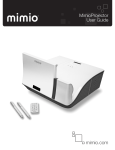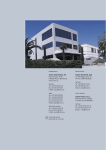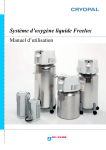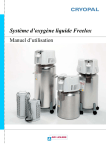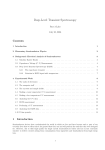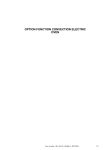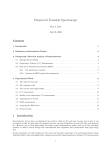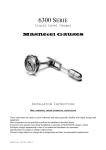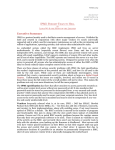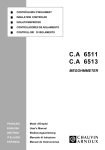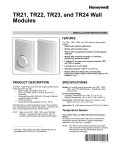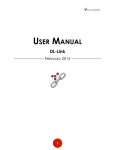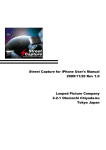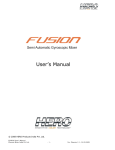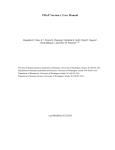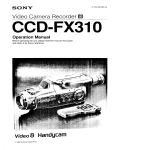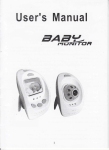Download Pressurisable vessels at less than 0.5 bar
Transcript
Pressurisable vessels at less than 0.5 bar TR type User’s manual 1 NH78388 Copyright 2012-2013 by Cryopal Document code: NH78382 - English version Edition March 2013 – Version D All rights reserved. This document may not be reproduced in any form whatsoever, in whole or in part, without written permission from Cryopal. The information given in this manual is accurate to the best of our knowledge. This manual conforms to directive EEC 93/42 modified by directive EC 2007/47. Cryopal Parc Gustave Eiffel 8 Avenue Gutenberg CS 10172 Bussy Saint Georges F - 77607 Marne la Vallée Cedex 3 Tel : +33 (0)1.64.76.15.00 Fax : +33 (0)1.64.76.16.99 E-mail: [email protected] Web : http://www.cryopal.com 2 Table of contents 1. 2. About this manual ............................................ 5 1.1 Purpose of the manual ............................... 5 1.2 Who this manual is for ................................ 5 1.3 Structure of the manual .............................. 5 1.4 How to use this manual .............................. 5 1.5 Skimming the manual ................................. 5 1.6 The included CD......................................... 5 1.7 Trade names cited...................................... 5 Safety ................................................................. 7 2.1 Symbols used ............................................. 7 2.2 Operator safety........................................... 7 2.3 Precautions in the event of a fault .............. 8 2.4 Important Safety Elements (EIS) ................ 8 2.5 Destruction of the unit................................. 8 3. Components supplied ...................................... 9 4. General............................................................. 11 4.1 Guide to components ............................... 11 4.2 Function .................................................... 11 5. Description ...................................................... 13 5.1 Storage tank ............................................. 13 5.2 Main accessories ...................................... 13 6. Unpacking and installation ............................ 15 6.1 Unpacking................................................. 15 6.2 Installation................................................. 15 6.3 Installation checklist.................................. 15 7. Installing the components ............................. 17 7.1 DL3 pump ................................................. 17 7.2 Foot pump................................................. 18 7.3 Pouring handle ......................................... 18 7.4 Tipping cart ............................................... 19 8. Use ................................................................... 21 8.1 Storage precautions ................................. 21 8.2 Moving ...................................................... 21 8.3 Handling.................................................... 21 8.4 Filling the tank .......................................... 21 8.5 Drawing off ............................................... 23 9. Maintenance .................................................... 27 9.1 Preventive maintenance ........................... 27 9.2 Replacing the centring ring seal ............... 27 11. Spare parts.......................................................31 11.1 Storage tank..............................................31 11.2 DL3 pump..................................................31 11.3 Foot pump .................................................32 11.4 Accessories...............................................32 12. Warranty and limit of liability .........................33 12.1 Warranty....................................................33 12.2 Limit of liability...........................................33 13. Index .................................................................35 10. Technical specifications ................................ 29 10.1 Tank.......................................................... 29 10.2 DL3 pump ................................................. 30 3 4 1. About this manual 1.1 Purpose of the manual 1.5 This manual refers specifically to cryogenic storage tanks in the TR range, i.e. non-pressurised tanks intended for storing and transporting liquid nitrogen. 1.2 Who this manual is for This manual is for any professional who wishes to use a cryogenic container in the TR line. Skimming the manual Given the specific nature of the cryogenic products and storage tanks, we would advise against skimming through this manual. We strongly recommend reading the chapters thoroughly in the order given. 1.6 The included CD The accompanying CD contains: This manual in electronic pdf format. 1.3 Structure of the manual For ease of consultation, the structure of this manual follows the steps normally taken by the user, as described below: Topic Manuals issued by Cryopal. Note: you will need to have the software known as Acrobat Reader installed on your computer to be able to read or print from this pdf manual in pdf format. Page Overview of the TR tank 13 1.7 Assembly (standard components and options) 17 Adobe and Adobe Acrobat Reader are trademarks of Adobe Systems Incorporated. Use 21 Maintenance 27 Technical specifications 29 1.4 Trade names cited How to use this manual The actions described in this manual are in the same sequence as those followed by the users of the product (see section 1.3). 5 6 2. Safety 2.1 Symbols used Symbol Meaning Important information about using the equipment. Failure to follow the instructions given for this point does not result in danger for the user. Warning: General danger. In this manual, failure to observe or implement the instructions preceded by this symbol may cause bodily harm, or may damage the equipment and installations. Name and address of manufacturer. Mandatory: read the manual. Mandatory: Protect your hands using appropriate personal protection equipment. Warning: Must wear protective goggles. This symbol means: Warning: Room must be ventilated. To maintain perfect operating conditions and ensure that the equipment is used safely, you must follow the instructions and take note of the symbols given in this manual. The tank has been designed for use with liquid nitrogen only. The equipment is visibly damaged. The equipment no longer particularly to accessories). works (applies After prolonged storage in unsuitable conditions. After severe damage sustained during transit. 2.2 Operator safety 2.2.1 General safety precautions Only personnel who have fully read this manual and the safety recommendations (see NH78380) are authorized to handle and use the apparatus described in this document. Like every other system, your apparatus may be subject to a mechanical failure. The manufacturer cannot be held liable for any production losses subsequent to defective operation of the kind described above, even during the warranty period. If the cryogenic tank appears to have an operating fault when used under normal conditions, only properly trained and qualified personnel are permitted to service it. The user must not be permitted to attempt repairs as this could present a risk to that person's health and/or safety. The equipment described in this manual is designed exclusively for use by qualified personnel. Maintenance operations should only be carried out by qualified and authorized personnel. To ensure the safe and correct use of the device during service and maintenance, it is essential that all personnel observe standard safety procedures. When the device cannot be used in conditions of total safety, the equipment should be withdrawn from service and protected against accidental usage. Full safety cannot be guaranteed in the following cases: 7 2.2.2 Safe use of liquid nitrogen The temperature of liquid nitrogen is -196 °C. As a result: You must never touch objects which have been in contact with liquid nitrogen with your bare hands. Always wear special gloves and visors when handling liquid nitrogen. Liquid nitrogen used in storage freezing chambers evaporates into the air; 1 litre of liquid nitrogen releases around 700 litres of nitrogen in the gaseous state. Nitrogen is an inert, non-toxic gas, but displaces oxygen when released into the atmosphere. Once the atmospheric oxygen content falls below 19% the human organism is at risk. Any room or place where liquid nitrogen containers are kept must always be completely ventilated and, at least, equipped with an oxygen detector; it should not be used for other purposes than those defined by your integrator. All personnel should be informed of the risks associated with the use of nitrogen. The storage tank is designed for use with liquid nitrogen only. According to the ADR directive on transporting dangerous goods by road, in order to avoid falling under the TPED directive, TR tanks must be transported without being under pressure (at atmospheric pressure) and with their neck open. It is prohibited to move the tank with its control head installed. It may only be moved when the neck is open. The neck of the tank must never be hermetically sealed. Use the stopper provided. The tank must always be kept vertical. The tank must always be transported empty, in its original packaging and in compliance with the current national and international regulations. Never stack storage tanks on top of each other. 8 2.3 Precautions in the event of a fault If you suspect that the integrity of the equipment has been compromised (for example as a result of damage sustained during transit or during use), it should be withdrawn from service. Make sure that the withdrawn equipment cannot be accidentally used by others. The defective equipment should be handed over to authorized technicians for inspection. 2.4 Important Safety Elements (EIS) These EIS are: Design rules for the EC Medical directives. Technical documentation instructions and services), (maintenance Components integral to the products (valves, solenoid valves, electronic equipment such as control and traceability electronics, overflow prevention and degassing devices, sensors and interfaces for remote monitoring (by an automation controller, etc.), the cover contact); these elements are not necessarily present on the product. Obligatory safety recommendations or advice (the wearing of personal protection equipment when using our products, instructions for the use of equipment etc.). During filling and transfer operations, ensure that equipment and procedures that ensure safety are used (hose, vacuum valve). 2.5 Destruction of the unit In order to protect the environment the equipment (the tank and its peripheral equipment) must be disposed of via the proper channels. 3. Components supplied The product is delivered complete with: Ref. Designation Quantity 1. TR tank (see table of capacities page 29). 1 2. Insulating stopper. 1 3. CD-Rom with this manual in pdf format. 1 Tableau 1 : Delivered parts. Figure 3-1 : The delivered parts. 9 10 4. General 4.1 Guide to components This illustration shows the main parts, both included ones and options that make up a storage tank in the TR product line. These are described in greater detail in the following paragraphs and pages. The tanks will be used in an appropriate environment. Figure 4-1: Overview of the parts that can be fitted on a type TR storage tank. 4.2 Function Cryogenic tanks in the TR line and unpressurised aluminium tanks, intended to store and transport liquid nitrogen. 11 12 5. Description This section describes the two main parts, i.e. the storage tank and the control head. 5.1 Storage tank N° Function 1. Handle. 2. Head flange, nom. dia. 50 mm. 3. Annular space safety device. The tank consists of the following parts: 4. Tank. The tank itself (4), consisting of two vessels made of a light alloy with a collar of glass fibre and epoxy resin composite. It is thermally insulated by maintaining a vacuum in the space between the two vessels and by several layers of insulation on the internal nternal one. The exterior of the tank is coated with polyurethane paint for a good finish and durability. 5. Stopper. A DN50 head flange (2), onto which different withdrawal systems are fastened (see next section) One or two handles (1) depending on capacity. An insulating stopper (5) that limits nitrogen loss. This stopper must be placed on the flange whenever the control head is not fitted on the tank. Two self-adhesive adhesive labels carrying warnings and product identification. The technical specifications are given on page 29. 5.2 Main accessories These accessories are not supplied with the standard version and must be ordered separately. 5.2.1 Foot pump system It consists of the following parts: A foot pump (rep. 5). A pipe (4) connecting the foot pump to the stopper (3). A spout out through which the liquid nitrogen passes (1) as a result of pressure created by the foot pump. Un bec par lequel sort l’azote liquide (rep. 1) du fait de la pression créée par la pompe à pied. An anti-splash fitting (2). Figure 5-1 : Overview of the tank. Figure 5-2 : View of the withdrawal system system. 13 5.2.2 DL3 withdrawal system. It consists of the following parts: A bent tube (1) through which the liquid nitrogen passes out of the tank. 5.2.3 Dolly base This base (1) can be firmly clamped to the tank and enables it to be moved inside a building, making it easier to negotiate uneven floors. It has four castors and a foot brake. A star knob (2) fitted on the end of the withdrawal tube (3), which controls the rate of flow of liquid nitrogen. A control head (5) which fits over the flange of the tank. The control head also supports a safety sa valve (4). A clamping ring (7) and collar. A pressure gauge (6). A manual valve (rep. 8) to relieve pressure inside the tank, also used to regulate the compressed nitrogen supply pressure. A relief outlet or pressure inlet (9). In the latter case this outlet is connected to a source of compressed nitrogen which builds up sufficient pressure to eject the liquid nitrogen. Figure 5-4 : Containers rs with and without dolly base base. 5.2.4 Tilting cart It is more particularly intended for TR21 to TR35 tanks. Two support models (rep. 1) are available: Model for TR21 and TR26 tanks. Model for TR35 tanks. Figure 5-5 : View of the cart. Figure 5-3 : View of the DL3 withdrawal system. system N°. Function 1. Bent tube. 2. Liquid withdrawal valve With star knob or quarter-turn valve. 3. Withdrawal tube. 4. Safety valve. 5. Control head. 6. Pressure gauge. 7. Clamping ring and collar. 8. Relief valve. 9. Relief outlet or pressure inlet. 14 5.2.5 Pouring handle The pouring handle (1) assists in handling, particularly when liquid nitrogen is being transferred from the TR storage tank into a smaller container. Figure 5-6 :The The pouring handle being used used. 6. Unpacking and installation 6.1 Unpacking For your own safety you must observe the safety rules and use suitable tools for unpacking and personal protection equipment. 6.3 Installation checklist Action Yes, done No, not done Check the general condition of the apparatus. Check the condition of the packaging on delivery. Are users trained? Place the package down in such a way that the marking on the carton are pointing in the desired unpacking direction. Does the room satisfy safety regulations and standards in force? Are the dimensions of the room (in particular the clear ceiling height after opening the lid) suitable for installation of the medical apparatus? Is access to the room limited to persons entitled to enter it? Are safety instructions and risks related to liquid nitrogen posted? Are instructions available/accessible close to it? Is personal protection equipment available/accessible in the room? Is the room equipped with a permanent ventilation system suitable for the size of the room? At least two able people are needed to unpack the assembly. Cut the straps and remove the lid. Remove the tank. 6.2 Installation The customer is responsible for ensuring that the premises comply with current regulations and safety standards and with the following recommendations. The maximum pressure of liquid nitrogen supply must be below 3 bars (1.5 bar recommended). Using a higher pressure may damage the equipment. The pressure of the portable tank reservoir should not exceed 0.5 bar. The volume of liquid nitrogen available is determined by the quantity of liquid present between the minimum level and the maximum filling level in the supplying tank. Before connecting the flexible filling line to the supplying tank or the liquid nitrogen supply it is important to purge the lines with dry nitrogen in order to remove any trace of moisture. Is the room equipped with an oxygen content checking system (display outside the room)? 15 Action Yes, done No, not done Are safe distances observed (at least 0.5 m around the apparatus)? Is the liquid nitrogen supply pressure lower than 3 bar? Has the apparatus being blown through (to eliminate all traces of humidity)? 16 7. Installing the components This section describes the addition of the various peripheral devices (dolly base, DL3 pump, foot pump, pouring handle, cart). 7.1 DL3 pump The optional DL3 pump is fitted as follows: Figure 7-2: DL3 pump, step 1. 4. Position the securing flange ((Figure 7-3, rep. 2) and fasten it hand-tight. 5. Close the relief valve (Figure Figure 7-3, rep. 1). Figure 7-1: the optional DL3 pump. 1. Screw on the bent part (1) at the star knob or quarter-turn turn valve (2), orienting it as illustrated. Note that it is possible: - to connect a hose directly in place of the bent part. The valve does in fact have a standard type 130 connection. - to weld, on the bent outlet, an optional poral filter. 6. You can connect a gradual pressurising system with a cylinder, linder, or wait for the system to reach the right pressure by natural wastage. 2. Fit the seal (4) over the flange of the tank. 3. Insert the lower part of the pump partway (Figure ( 7-2,, rep. 3) into the tank, taking care not to bang the neck of the inner tank. The relief valve (Figure 7-2, rep. 1) shall be opened as a safety measure. Figure 7-3: DL3 pump, step 2. Note: the the tube (3) may need to be recut to adjust its overall height for the intended use. Unscrew the top part of the pump (Figure Figure 7-2, rep. 2) to release the pipe to be immersed (Figure ( 7-2, rep. 3). Adjust its length so than it does not touch the bottom of the tank before you tighten the upper part (Figure 7-2, rep. 2). 17 7.2 Foot pump 7.3 Pouring handle The optional foot pump is fitted as follows: 7.3.1 Fitting the handle 1. Connect up the components as shown. Proceed as follows to ffit the pouring handle onto the tank: 1a.Screw Screw the plastic end (rep. 3) onto the orifice marked INFL (rep. 3) on the pump. 1b.Next, join the other end of this plastic end piece (rep. 3) to the small bent pipe (rep. 1) on the stopper, using the transparent plastic pipe (rep. 2). 1. Unscrew the knurled handle. 2. Slide the pouring handle on, taking care not to damage the base of the tank. Figure 7-6:: pouring handle, step 1. 3. Position the pouring handle (2) so that the knurled handle is on the same side as the pumping valve (1) Figure 7-4: foot pump, step 1. 2. Slide the stopper (1) to adjust the length of the pipe (2) that will be inside the tank, depending on how deep it is. Figure 7-7:: pouring handle, step 2. 4. Screw in the knurled handle until it is firmly mounted on the tank. 7.3.2 Figure 7-5: foot pump, step 2. Removing the handle Proceed as follows to remove the pouring handle from the tank: 1. Unscrew the knurled handle. 2. Slide the pouring handle down off the tank. 18 Figure 7-8: removing the pouring handle. 7.4 Tipping cart To mount the tank on the cart, proceed as follows. 1. Position the empty tank in the ring, with the pumping valve (1) pointing upwards. Warning: there are 2 different types of tilting cart to suit different types of storage tank (see section 5.2.4, on page 14). 2. Tighten the screw (rep. 2) and check that it is secure. Figure 7-9: tipping cart. 19 20 8. Use This section describes the use of the assembled tank during transport, handling, filling (by gravity or from a type TP supply tank) and withdrawal (using the liquid nitrogen). 8.1 Storage precautions Before installing the equipment or using it for the first time, it is essential to refer to the safety instructions on page 7. 8.4 The tank can be filled by one of the following methods: By gravity, pouring the liquefied gas as one would from a bottle. From a refill tank (a TP tank, line, etc.) using the right hose for that refill tank. For any operation with a liquefied gas you must wear protective gloves and goggles. Mandatory: Protect your hands using appropriate personal protection equipment. The storage tank must always be kept sheltered from exposure to the elements, with its control head or stopper fitted. 8.2 The gas transferred is at a very low temperature. Moving Tanks can be full or empty when moved overland, provided that they are open to atmosphere, i.e. with the stopper fitted. Never seal a tank; use the stopper provided. The pressure inside the tank must be atmospheric pressure. This is simply achieved by inserting the stopper provided so as to restrict loss of nitrogen and prevent the entry of moisture. The insulating stopper provided improves the rate of evaporation of the liquid nitrogen by 35%. 8.3 Handling The TR line of products has been designed to withstand the impacts that are unavoidable when a tank is moved. Nevertheless, to minimise the rate of loss and maximise the service life of tanks, we strongly recommend that you: Avoid severe impacts. Keep tanks upright at all times. Only move a tank inside the same laboratory (do not use the tank as an intensive transport tank). Filling the tank When filling, ensure that no personnel or equipment is near the place of transfer. 8.4.1 Refilling from a refill tank Refer to the TP tank manual. 8.4.2 Filling from a TR tank This filling operation shall be carried out with or without a cart, depending on the size of the refill tank. The procedure consists in transferring the liquid nitrogen by gravity (pouring from one tank into another). It can only be done with tanks that are not too heavy for the operator. Refer to the safety notes in section 8.4, in page 21. The tank must never be left unattended during the filling stage. 1. Remove the stopper. 2. Hold the tank as shown. If possible, use the optional dolly base. 21 Figure 8-1: filling from a TR vessel; step 1. Figure 8-3:filling :filling with a DL3 pump in place; step 1. 3. Pour the liquid nitrogen into the tank up to the desired level. The highest permitted level of liquid is the lower edge of the neck. The quantity of liquid nitrogen introduced can be checked by weighing, given that 1 litre of liquid nitrogen itrogen has a mass of approximately 0.808 kg at atmospheric pressure. Please refer to the table in section 10.1 on page 29for the weights. 4. Open the relief valve (5) ((Figure 8-4, rep. 5). 5. Open the star knob ((Figure 8-3, rep. 4). 6. Filling is completed when liquid comes out of the end (Figure 8-4,, rep. 7) of the relief valve. 7. Close the star knob ((Figure 8-3, rep.4) and the relief valve (Figure 8 8-4, rep. 5). Make sure not to overfill the tank during manual filling so as to avoid rupturing the vacuum in the inner wall (liquid nitrogen coming in contact with the pump check valve 1). Figure 8-4:: filling with a DL3 pump in place; step 2. Take caution to avoid being burned by cryogenic liquid coming out through the relief valve's tip (rep. 7). Figure 8-2: filling from a TR vessel; warning. 8.4.3 Filling with an installed DL3 pump 1. Check that the star knob or quarter-turn quarter valve (4) is closed, just like the relief valve. 2. Unscrew screw the nut (2) and remove the bent part (1) 3. Connect a flexible line from the supply tank to the end piece (3). 22 If a pressure of 0.3 bar is maintained during filling the tank can be used immediately. If it has not, wait for the tank pressure to rise. 8.5 Drawing off Drawing off consists in transferring the liquid nitrogen from the tank to another container. It is carried out using specially designed draw off equipment (simplified draw off apparatus, a foot pump or DL3 device) fitted to the neck of the tank. 8.5.1 2. To stop the draw off, remove the pipe (2) from the container (1). The draw off takes place because of heat from the pipe entering the container 3. For repeated filling operations operations, allow the pipe to warm up for a few minutes to reach external temperature. Safety Nitrogen should be handled in a suitably ventilated room, preferably with an oxygen level detector installed. Indeed, nitrogen is neither toxic nor flammable, but may cause oxygen depletion in confined spaces. The manual draw off pipe is provided only for filling small capacity containers. During the various draw off operations, cryogenic gloves or protective glasses must be used. 8.5.2 Draw off using the simplified apparatus 8.5.2.1 Setting up 1. Unscrew the black handle (1) to release the reflector (2). Lift up the rubber plug (3). 2. Gently lower the pipe (8) down to the bottom of the preferably empty tank. If the tank is full, there is a risk of nitrogen splashes. The pipe outlet should be turned towards a safe area before handling. 3. Raise the pipe by 2 to 3 cm, then adjust the plug (6) to the height of the neck (7). 4. Lower the reflector (5) then re-tighten tighten the black handle (4). Figure 8-6: drawing off. 8.5.3 With the foot pump Proceed as follows: Refer to the safety notes in section 8.4, in page 21. The tank must never be left unattended during the withdrawal stage. 1. Before starting, blow dry air or nitrogen through the lines and the valves to remove any moisture. 2. Fit the foot pump as shown in section 7.2, in page 18. 3. Fit the foot pump onto the neck of the TR tank. 4. Place the anti-splash splash device (1) into the receiving tank. 5. Pump with the foot until the liquid reaches the maximum level in the receiving tank. Figure 8-5: setting up stages for drawing off. 8.5.2.2 Procedure 1. Lower the draw off pipe whilst holding the container to be filled (1) up to the pipe outlet and hold the pipe using the handle (2) without pressing hard. Filling is instantaneous. 23 Figure 8-7: transferring with the foot pump. Proceed as follows: 8.5.4 1. Open the liquid withdrawal valve (Figure 8-9, rep. 1). Check that the pressure is lower than 0.5 bar (Figure 8-9, rep. 2). With the DL3 pump Positioning the DL3 pump Refer to the safety notes in section 8.4, in page 21. The tank must never be left unattended during the withdrawal stage. 2 1 1. Before starting, blow dry air or nitrogen through the lines and the valves to remove any moisture. 3 4 2. Fit the pump as shown in section 7.1, in page 17. 3. Check that the relief valve (4) and the liquid withdrawal valve (3) are closed. Beware of possible splashes of nitrogen. Figure 8-9: using the DL3 pump. 2. Once liquid is coming out, the withdrawal valve (Figure 8-9, rep. 1). can be opened more fully 3. Close the withdrawal valve (Figure 8-9, rep. 1) to stop more nitrogen from coming out. Note: if a nitrogen gas cylinder is connected (4), adjust the valve (3) too in order to control the flow of liquid nitrogen. Removing the DL3 pump Refer to the safety notes in section 8.4, in page 21. Figure 8-8: transferring with the DL3 pump. 4. Close the relief valve (4) again. 5. Connect either the bent pipe (1) or a suitable flexible line to the 130 mm nut (2). Using the DL3 pump It is important to note that the tank becomes pressurised by natural losses. Consequently the length of time it takes before it is available for use will vary. Note: In order to be able to use the device immediately the connection on the relief valve (6) can be used (no. 7 in figure on previous page) to connect a tube via which the tank can be rapidly pressurised from, for example, a small bottle of nitrogen gas. 24 Figure 8-10: removing the DL3 pump. 1. Disconnect the pressurisation pipe (4), if used, from the relief valve (3) 2. Check that the withdrawal valve (1) is properly closed. 3. Open the relief valve (rep. 3). 4. Wait until gas is no longer flowing at the connection (4) of this valve before going on to the next step. 5. Remove the clamping ring (rep. 5). 6. Remove the pump from the tank. 7. Dry the pump all over before storing it where it will not suffer any impacts. 25 26 9. Maintenance This section summarizes the procedures for inspecting and changing the components of the control head. It also describes calibration of the pressure gauge. 9.1 9.2 Replacing the centring ring seal This is necessary if leaks are detected here. Change the ring and seal assembly. Preventive maintenance This section is for skilled and qualified persons who are authorized to carry out maintenance work. Maintenance is necessary to ensure that the equipment remains in normal operating condition. The person who uses the equipment is responsible for this. The tools used for maintenance operations must be non-abrasive and should have no sharp edges or points that could damage the surfaces. Operation Frequency Cleaning the outside of the tank Important note: cleaning is limited to the outer parts of the device. The use of acetone, solvents or any other highly flammable chemicals or liquid-containing chlorine products is prohibited. Wipe the plastic parts with a dry rag and, if necessary, with a slightly moist non-abrasive sponge (do not use abrasive powder) or with impregnated wipes. Ordinary domestic cleaning products (slightly abrasive creams containing ammonia) applied with a sponge will be acceptable for the tank and the stainless steel parts. Afterwards, rinse with a damp rag, then wipe and leave to dry. Every weeks (*) Airtight seal Every year Safety valve Every year 5 (*)The frequencies shown are guideline intervals and should be adjusted by the user according to the use made of the equipment. 27 28 10. Technical specifications 10.1 Tank Unity TR7 TR11 TR21 TR26 TR35 TR60 TR100 Total capacity Litres 7 12 21 26 33 60 99 Working capacity Litres 7,2 12,2 21,5 26 33,6 60 99 Diameter of neck mm 50 50 50 50 50 50 50 Weight when empty kg 6 7,5 11 13,5 15,8 21,5 29,5 Weight when full of nitrogen kg 11,8 17,3 28,3 34,6 43 70 110 External diameter (D) mm 308 308 388 388 468 468 510 Overall height (H) mm 480 584 605 669 655 869 986 Evaporation per day (1) Litre/day 0,2 0,18 0,18 0,2 0,24 0,4 0,55 Static duration of use Day 36 67 119 130 140 150 180 Total internal height mm 405 530 535 612 580 800 933 A A P P P P P Handles(A) or (P) Working temperature °C 20 20 20 20 20 20 20 Storage temperature °C <50 <50 <50 <50 <50 <50 <50 (1) Daily evaporation and static duration of use are given for 20 °C, 1013 mbars, with the tank stationary and the stopper closed. These are nominal values and may vary depending on the history of the tank and manufacturing tolerances. Figure 10-1: dimensional characteristics (dimensions in mm). 29 10.2 DL3 pump Feature Principal characteristics Height 1 m. Nitrogen pressure Pressure gauge (graduation from 0 to 1 bar). Installation Flange. Valves Filling / withdrawal. Vent / overflow. 30 11. Spare parts 11.1 Storage tank Item Stopper Code ACC-TR-14 11.2 DL3 pump Item DL3 pump, complete Code ACC-TR-5 Pressure gauge ACC-TR-19 Safety valve ACC-TR-8 Seal for centring ring ACC-ALU-16 Centring ring, complete (with seal) ACC-ALU-14 Liquid withdrawal valve, nom. dia. 12 mm ACC-TR-6 Membrane and shutter assembly for liquid withdrawal valve, nom. dia. 12 mm ACC-TR-7 Clamping ring ACC-ALU-15 Complete control head (pressure gauge, clamping ring, seal, centring ring, valve, relief valve) ACC-TR-11 Control head nut ACC-TR-12 Gland packing ACC-TR-13 Relief valve ACC-TR-21 Withdrawal tube ACC-TR-23 Bent tube ACC-TR-24 31 11.3 Foot pump Item Foot pump, complete Code ACC-TR-1 11.4 Accessories Item Elbow with anti-splash device Code ACC-TP-17 Anti-splash device ACC-ALU-12 Adjustable dolly base Standard adjustable dolly base for TR21/TR26/TR35/TR60/TR100 ACC-ALU-29 Non-magnetic adjustable dolly base for TR35/TR60/TR100 ACC-ALU-31 Lock kit (3 units) ACC-ALU-32 Item ACC-TR-14 Insulating stoppers Insulating stopper for TR 7/11/21/26/35/60/100 ACC-TR-17 Cart ACC-TR-18 Cart for TR21 and TR26 Cart for TR35 ACC-TR-16 Pouring handle ACC-TR-15 Pouring handle for TR21 and TR26 Pouring handle for TR35 ACC-FL180TCNL-08 Hoses ACC-FL180TCNL-15 180TC hose for nitrogen, nom. dia. 10 mm, 800 mm long ACC-FL630TCNL-15 180TC hose for nitrogen, nom. dia. 10 mm, 1500 mm long ACC-FL630TCNL-20 630TC hose for nitrogen, nom. dia. 16 mm, 1500 mm long ACC-FL630TCNL-15 630TC Flexible line for nitrogen, nom. dia. 16 mm, 2000 mm long ACC-FL630TCNL-20 32 12. Warranty and limit of liability 12.1 Warranty The warranty period takes effect on the date of issue of the equipment delivery note and has a duration of one year. Goods are delivered at the vendor’s risk if delivered by a carrier appointed by Cryopal. In other cases delivery is at the buyer’s risk. The vendor guarantees the equipment against all design faults and defects of manufacture and construction affecting the storage tanks. The seller's guarantee is strictly limited, at the seller's discretion, to repairing or replacing the parts which it acknowledges as defective and to its labour expenses other than transport and packing charges. affiliate companies, successors or concession holders, in connection with the materials sold; this provision includes without limitation actions concerning personal injury, damage to goods not covered by the agreement, indirect or immaterial losses or damage and particularly loss of use or of profit, loss of cryogenic liquid or of products in storage etc. Within the limits imposed by applicable legislation, the buyer undertakes to compensate the vendor, its employees, affiliate companies, successors and concession holders, for all claims, complaints, demands, court orders, convictions or liabilities of any nature, as well as all costs and expenses incurred by or imposed on the vendor in connection with the materials sold. The repair, modification or replacement of parts during the guarantee period does not extend the duration of the guarantee. Replacement parts must be used in the conditions of service originally defined by the vendor. In particular, safety devices sold as replacement parts must be installed as replacements for the original safety devices in conditions of service (pressure, temperature, gas, valve diameter etc.) identical to the original</cf> To qualify for the guarantee, the user must submit a claim to the vendor within 15 days of its receipt of the equipment, accompanied by the delivery note. Application of this guarantee takes place in accordance with the vendor’s general terms and conditions of sale. Replaced defective parts become the property of the vendor. The required repairs, modifications or replacements due to normal wear and tear, deteriorations or accidents from faulty operation, insufficient supervision or maintenance, negligence, overloads, a use not conforming to the utilization regulations, as well as shocks, drops, or degradations due to bad weather are not covered by the guarantee (see the operating instructions). This guarantee is immediately invalidated in the event of the replacement or repair of original parts by persons not duly authorized by Cryopal. Within the limits imposed by applicable legislation, it is expressly agreed that the guarantee awarded in this article is the only guarantee implicitly, explicitly or lawfully granted by the vendor with regard to the materials sold, and that, except where stated to the contrary in writing, the buyer renounces entitlement to any legal action which the buyer (or its employees, affiliate companies, successors or concession holders) might take against the vendor, its employees, 12.2 Limit of liability Neither Cryopal, nor any related company, may under any circumstances be held liable for any damages, included but not limited to damages for loss of manufacture, interruption of manufacture, loss of information, defect in the indicator or its accessories, bodily harm, loss of time, financial or material losses, or for any consequences whether indirect or subsequent to a failure occurring in the course of use, or inability to use the product, even in a situation where Cryopal had been made aware of such damages. 33 34 13. Index Foot brake, 14 Overview, 14 A Accessories, 32 Dolly base, 32 Hose, 32 Insulating stopper, 32 Pouring handles, 32 Tilting cart, 32 Airtight seal Replacement, 27 Anti-splash device, 23 C Centring ring Replacement, 27 Cleaning, 27 Components, 11 Components supplied, 9 Composants, 11 Copyright, 2 D Description, 13 Destruction, 8 DL3, 14 Installation, 17 Positioning, 24 Removal, 24 Spare parts, 31 Specifications, 30 Use, 24 DL3 pump Installation, 17 Positioning, 24 Spare parts, 31 Specifications, 30 DL3:External nitrogen cylinder, 14 DL3:Manual valve, 14 DL3:Pressure control, 14 DL3:Pressure intake, 14 DL3:Relief outlet., 14 DN50, 13 Dolly base Accessories, 32 E EIS, 8 E-mail, 2 Equipment Destruction, 8 F Fault, 8 Foot brake, 14 Foot pump Installation, 18 Positioning:, 23 Spare parts, 32 Use, 23 Function, 11 G General, 11 General safety, 7 H Handle, 13 Head flange, 13 Hose Accessories, 32 http, 2 I INFL, 18 Inner wall, 13 Installation, 15 Checklist, 15 Installing the components, 17 L Limit of liability, 33 M Maintenance, 27 Manual, 5, 9 Purpose, 5 Readership, 5 Skimming, 5 Structure, 5 Use, 5 Moving, 21 O Overview DL3 pump, 14 Dolly base, 14 Foot pump, 13 Pouring handle, 14 Tank, 13 Tilting cart, 14 P Page Web, 2 Pompe à pied INFL, 18 Positioning Foot pump, 23 Positioning the DL3 pump, 24 Pouring handle, 14, 32 Disassembly, 18 Fitting, 18 Pump check valve, 18, 19, 22 R Récipient Soutirage, 23 Utilisation, 23 Removal DL3 pump, 24 S Safety, 7 Liquid nitrogen, 8 Operators, 7 Site web Cryopal, 2 Skimming, 5 Soutirage Avec dispositif simplifié, 23 35 Mode opératoire, 23 Sécurité, 23 Spare parts DL3 pump, 31 Foot pump, 32 Specifications DL3 pump, 30 Stopper Accessories, 32 Stopper:Insulating, 13 Stopper:Stopping, 13 Storage Tank, 21 Structure of the manual, 5 36 T U Tank, 13 Cleaning, 27 Filling, 21 Handling, 21 Maintenance, 27 Moving, 21 Storage, 21 Tilting cart, 14 Accessories, 32 Description, 14 Tipping cart Fitting, 19 Trade names cited, 5 Unpacking, 15 Use, 21 DL3 pump, 24 Foot pump, 23 W Warranty, 33 Web, 2 Withdrawal system DL3 – overall view, 14 Foot pump – overall view, 13 www, 2 37 38







































